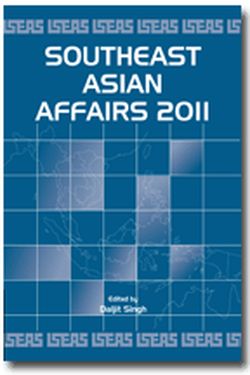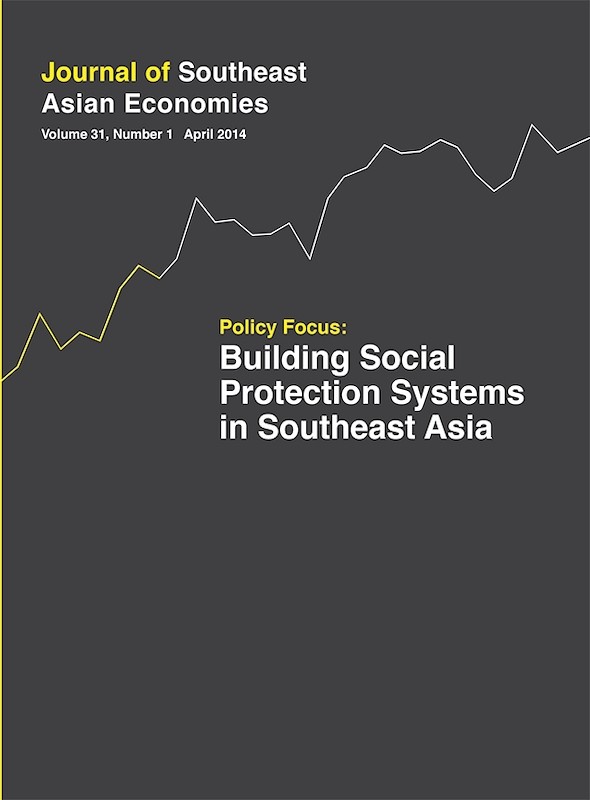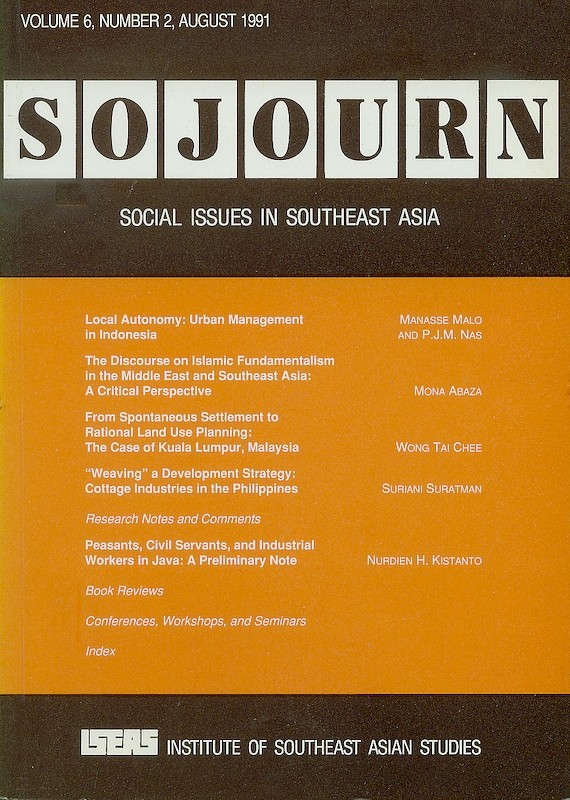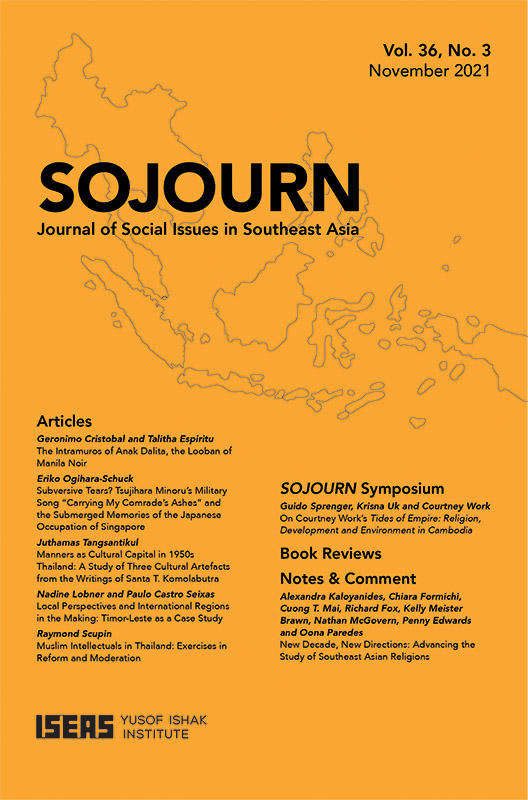SOJOURN: Journal of Social Issues in Southeast Asia Vol. 24/2 (Oct 2009)
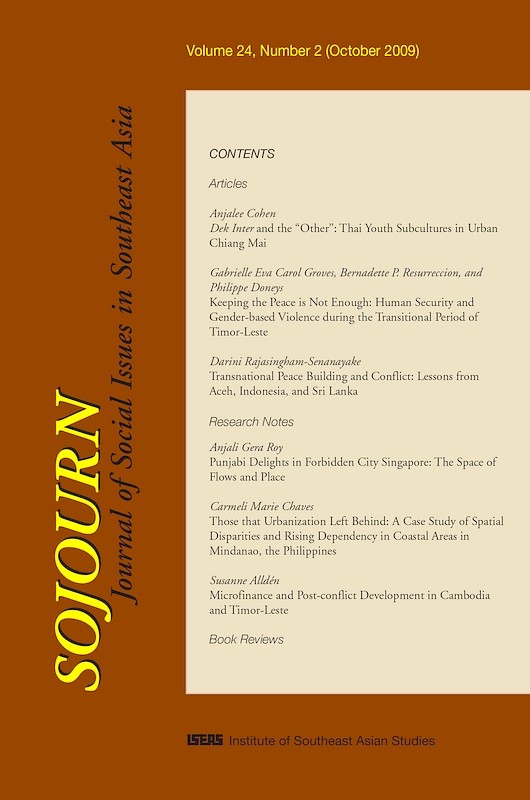
Date of publication:
October 2009
Publisher:
Institute of Southeast Asian Studies
Number of pages:
145
Code:
SJ24/2
Contents
-
SOJOURN: Journal of Social Issues in Southeast Asia Vol. 24/2 (Oct 2009)
[Whole Publication] -
Preliminary pages
- ARTICLES
-
Dek Inter and the "Other": Thai Youth Subcultures in Urban Chiang Mai, by Anjalee Cohen, author see abstractRapid urbanization in northern Thailand over the last few decades has led to the growing movement of young people from rural villages to the city. As Thai youth lose ties with their village communities, new forms of belonging are being sought through urban subcultures. This paper explores the emergence of various youth subcultural groups in Chiang Mai and illustrates how these groups use visual and performative style to create their own symbolic community. In particular, it demonstrates how young northern Thai people attempt to form a "modern" identity through the construction of subcultural boundaries and the categorization of a "backward" other.
-
Keeping the Peace is Not Enough: Human Security and Gender-based Violence during the Transitional Period of Timor-Leste, by Gabrielle Eva Carol Groves, Bernadette P. Resurreccion, Philippe Doneys, authors see abstractHuman security has been defined as people-centred and inextricably linked to development. This concept challenges the traditional security paradigm with its exclusive focus on the protection of the state and its sovereignty from conflict and immanent threats. By focusing on incidences of gender-based violence, this paper attempts to demonstrate the shortcomings of the UN peace-keeping mission and interim government in Timor-Leste in recognizing and redressing forms of violence and conflict other than those that threatened the new nation-state during the transitional period. Through the prism of gender-based violence, the paper argues that indigenous normatives and adjudication on gendered violence co-exist with the liberal principles of state-centric security and are mutually reinforcing. As a result, this has generated new forms of insecurity, stoking the uneasy peace that continues to haunt the new nation-in-the-making.
-
Transnational Peace Building and Conflict: Lessons from Aceh, Indonesia, and Sri Lanka, by Darini Rajasingham-Senanayake, author see abstractGlobal attention generated after the December 2004 Asia tsunami disaster catalyzed one of the most successful internationally-mediated peace processes in the world in Aceh, Indonesia, but did not save the peace process in Sri Lanka. Rather, international aid contributed to a "no war, no peace" equilibrium in Sri Lanka that was brought to an end by the military victory of the government. This paper compares these two highly internationalized peace processes in Southeast and South Asia, particularly, the role of international actors in reconstruction, and analyses the reasons for the different outcomes. Based on ethnographic fieldwork, the paper traces how transnational aid networks, discourses and practices may become endogenous in local or internal conflicts and peace dynamics over time. Finally, it is clear that inclusive and comprehensive peace building, as well as the space for transformation of conflicting groups, is the key to successful peace building.
- RESEARCH NOTES
-
Punjabi Delights in Forbidden City Singapore: The Space of Flows and Place, by Anjali Gera Roy, author see abstractBringing place-centredness to the undifferentiated space of globalization, Saskia Sassen considers cities as strategic global sites and shows that transnationalized modes of production and consumption co-exist with "thick places" in the global city (Sassen 2006). Bhangra is now understood as a British Asian music produced by the hybridization of Punjabi dhol beats with western rhythms of pop, reggae, hip hop, and rap but it is derived from a Punjabi dance genre of the same name. By examining the multiple places in Singapore in which new Bhangra mutants are performed, this research note argues that the digitized circuits of consumption and entertainment in the global city foreground a new global politics of place formed through transnational ethnic networks.
-
Those that Urbanization Left Behind: A Case Study of Spatial Disparities and Rising Dependency in Coastal Areas in Mindanao, the Philippines, by Carmeli Marie Chaves, author see abstractUrban-rural disparities are exacerbated by failed livelihood projects, declining fishing incomes, and rising poverty levels in coastal areas in Mindanao, the Philippines. This has spurred the out-migration of young adults from the rural to urban areas. Faced with collapsing fisheries and a lack of income opportunities, families are compelled to abandon fishing and farming occupations for urban services jobs that give predictable and sustained incomes. The rural demographic picture that is emerging is one that is characterized by a changing household structure where the very young and the elderly stay home while the men and women of childbearing age migrate to urban areas for work. The high dependency in rural areas and urbanward migration have thus worsened urban-rural spatial inequalities.
-
Microfinance and Post-conflict Development in Cambodia and Timor-Leste, by Susanne Allden, author see abstractMicrofinance is increasingly being used to fight poverty and it is often seen as a strategic way to advance local economic development in war-torn developing societies. In Cambodia this strategy has been quite successful, but in Timor-Leste microfinance is considered less effective for poverty reduction. This article addresses how microfinance has developed in the two countries, what strengths and weaknesses can be detected, and how the differences between the two countries can be understood.
- BOOK REVIEWS
-
BOOK REVIEW: Political Regimes and the Media in Asia, edited by Krishna Sen and Terence Lee, by Duncan McCargo, author
-
BOOK REVIEW: Kinship and Food in Southeast Asia, edited by Monica Janowski and Fiona Kerlogue, by Judith Bovensiepen, author
-
BOOK REVIEW: Representation, Identity and Multiculturalism in Sarawak, edited by Zawawi Ibrahim, by Kee H Yong, author
-
BOOK REVIEW: The Graves of Tarim: Genealogy and Mobility across the Indian Ocean, by Engseng Ho, by Terenjit Sevea, author
- CONFERENCES, WORKSHOPS, AND SEMINARS
-
Call for Papers: Conferences-Workshops on "Engaging the Classics in Malay and Southeast Asian Studies: Where to From Here?", 1718 June 2010; Conference on "Historical Fragments in Southeast Asia: At the Interfaces of Oral History, Memory and Heritage", 23-24 June 2010; Conference on "The Culture of Value and the Value of Culture: The Socio-economic Life of Southeast Asian Art", 12 July 2010.


